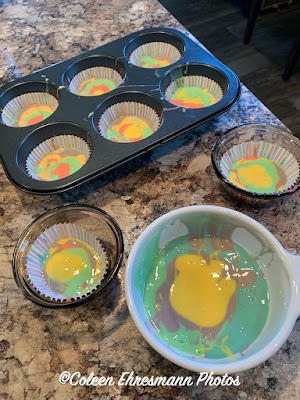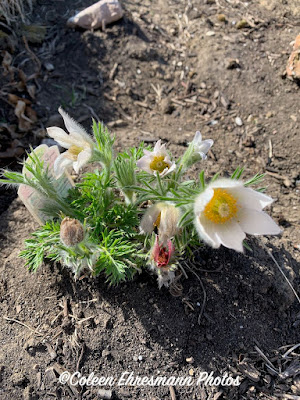I had found a recipe for Tie-Dye Cupcakes and because Miss W did not have a full-blown birthday party deserving of turning 10, I thought she might enjoy creating the cupcakes in the photo.
Of course she was willing to make Tie-Dye cupcakes! Besides, she had a new apron to wear when baking and cooking at Grandma's house. (This is her third apron since age 2.)
mixing the cake batter colors to just the right hue
rainbow colors
red, orange, yellow, green, blue, purple
layering the batter
second batch (leftovers) ready for the oven
Directions were something like: "layer large tablespoons of each frosting color around the side of the disposable piping bag in a clockwise direction." Yah. Right. Since neither Miss W nor I have experience with piping frosting, we got what we got!
practicing the process on the little birthday cake
she did a very good job of piping frosting
the end result
colorful and yummy
While the two of us were slaving away in the kitchen, Mr. M and grandpa were doing some litter clean-up in the wash behind the house. The tall grass collects lots of run-away/blown-away trash. The wash looks better without the pizza box and the shopping bags.
Saturday morning they made birthday cards and cards for their Mom for Mother's Day.
hard at work
no glitter this time as I am still finding glitter from
the Christmas projects
thank goodness for foam stick-ons
and then some of the crew got to relax
they went home about two before the next
visitors arrived
pasque flower
South Dakota's state flower
usually found in the wild, but I have a domesticated plant
that survived the winter
Woo Hoo!!!
Pulsatilla nuttalliana, known as American pasqueflower, prairie pasqueflower, prairie crocus, cutleaf anemone, or simply pasqueflower, is a flowering plant native to much of North America, from the western side of Lake Michigan, to northern Canada in the Northwest Territories, south to New Mexico in the southwestern United States.
Pasqueflower is the provincial flower of Manitoba and the state flower of South Dakota.
It was first formally named in 1817 as Anemone nuttalliana. It is sometimes considered a subspecies or variety of Pulsatilla patens (Anemone patens). ~ Wikipedia
and the tulips bloomed on Friday
nothing special, but a pop of color this time of year
















No comments:
Post a Comment
Thanks for your comments!